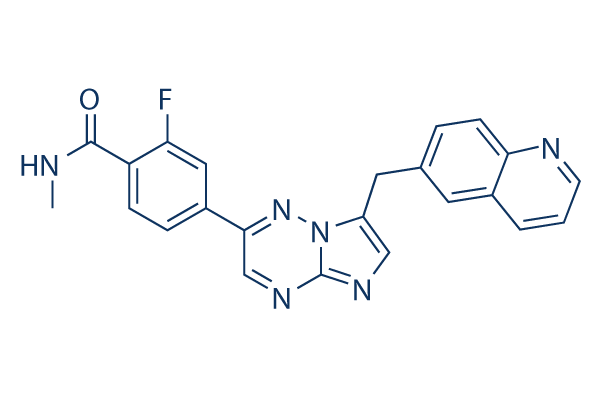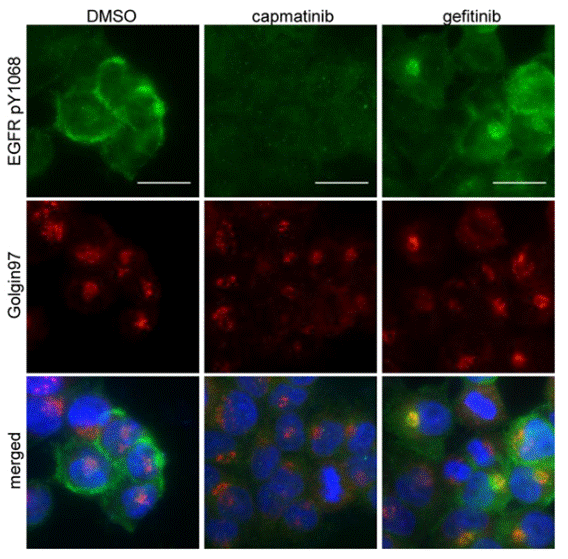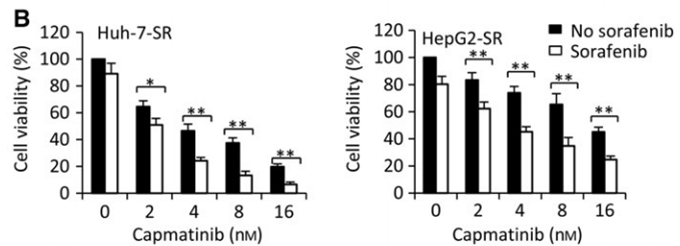research use only
Capmatinib c-Met inhibitor
Capmatinib is a novel, ATP-competitive inhibitor of c-MET with IC50 of 0.13 nM in a cell-free assay, inactive against RONβ, as well as EGFR and HER-3. This compound inhibits Wnt/β-catenin and EMT signaling pathways and induces apoptosis in diffuse gastric cancer positive for c-MET amplification. Phase 1.

Chemical Structure
Molecular Weight: 412.42
Purity & Quality Control
Related Products
| Related Products | SGX-523 Foretinib PHA-665752 SU11274 BMS-777607 JNJ-38877605 Tivantinib PF-04217903 Tepotinib Savolitinib (AZD6094) MGCD-265 analog Golvatinib (E7050) Merestinib (LY2801653) MK-2461 NPS-1034 AMG 337 Sodium L-ascorbyl-2-phosphate NVP-BVU972 BMS-794833 S49076 | Click to Expand |
|---|---|---|
| Related Compound Libraries | Kinase Inhibitor Library Tyrosine Kinase Inhibitor Library PI3K/Akt Inhibitor Library Cell Cycle compound library Angiogenesis Related compound Library | Click to Expand |
Signaling Pathway
Cell Culture and Working Concentration
| Cell Lines | Assay Type | Concentration | Incubation Time | Formulation | Activity Description | PMID |
|---|---|---|---|---|---|---|
| Huh7-SR | Cell viability assay | 0, 2, 4, 8, 16 h | 48 h | significantly reduced the viability and strengthened the effects of sorafenib on sorafenib-resistant cells | 28164434 | |
| HepG2-SR | Cell viability assay | 0, 2, 4, 8, 16 h | 48 h | significantly reduced the viability and strengthened the effects of sorafenib on sorafenib-resistant cells | 28164434 | |
| NCI-H1993 | Growth inhibition assay | 72 hrs | Growth inhibition of human NCI-H1993 cells after 72 hrs by CCK-8 assay, IC50 = 0.0023 μM. | 28411455 | ||
| SNU5 | Growth inhibition assay | 72 hrs | Growth inhibition of human SNU5 cells after 72 hrs by CCK-8 assay, IC50 = 0.0027 μM. | 28411455 | ||
| Click to View More Cell Line Experimental Data | ||||||
Mechanism of Action
| Features | Inactive against RONβ, another member of the c-MET RTK family, as well as EGFR and HER-3 (members of the EGFR RTK family). | ||||
|---|---|---|---|---|---|
| Targets |
|
In vitro |
||||
| In vitro | INCB28060 exhibits picomolar enzymatic potency and is highly specific for c-MET with more than 10,000-fold selectivity over a large panel of human kinases. This compound inhibits human c-MET phosphorylation and c-MET-mediated signaling in cancer cells. It inhibits c-MET-dependent cell proliferation and survival, and prevents anchorage-independent cancer cell growth and cell migration. [1] |
|||
|---|---|---|---|---|
| Kinase Assay | c-Met Kinase Assay | |||
| The assay buffer contains 50 mM Tris-HCl, 10 mM MgCl2, 100 mM NaCl, 0.1 mg/ml BSA, 5mM DTT, pH 7.8. For HTS 0.8 μL of 5 mM of this compound dissolved in DMSO are dotted on 384-well plates. DMSO titration suggests that the maximum tolerated concentration of the solvent is 4%. To measure IC50s the INCB28060 plate is prepared by 3-fold and 11-point serial dilutions. 0.8 μL of this chemical in DMSO is transferred from INCB28060 plate to the assay plate. The final concentration of DMSO is 2%. Solutions of 8 nM unphosphorylated c-Met or 0.5 nM phosphorylated c-Met are prepared in assay buffer. A 1 mM stock solution of peptide substrate Biotin-EQEDEPEGDYFEWLE-amide dissolved in DMSO is diluted to 1 μM in assay buffer containing 400 μM ATP (unphosphorylated c-Met) or 160 uM ATP (phosphorylated c-Met). A 20 μL volume of enzyme solution (or assay buffer for the enzyme blank) is added to the appropriate wells in each plate and then 20 μL/well of substrate solution to initiate the reaction. The plate is protected from light and incubated at 25 °C for 90 minutes. The reaction is stopped by adding 20 μL of a solution containing 45 mM EDTA, 50 mM Tris-HCl, 50 mM NaCl, 0.4 mg/ml BSA, 200 nM SA-APC and 3 nM EUPy20. The plate is incubated for 15-30 minutes at room temperature and HTRF (homogenous time resolved fluorescence) is measured on a Perkin Elmer Fusion α-FP instrument. The HTRF program settings used are as follows: Primary excitation filter 330/30, Primary window: 200 uSec, Primary delay: 50 uSec, Number of flashes: 15, Well read time: 2000 | ||||
| Cell Research | Cell lines | H441 cells | ||
| Concentrations | 0.24, 1, 4, 16, 63 nM | |||
| Incubation Time | 24 hours | |||
| Method | H441 cells are seeded in RPMI-1640 medium containing 10% FBS and grown to complete confluence. Gaps are introduced by scraping cells with a P200 pipette tip. Cells are then stimulated with 50 ng/mL recombinant human HGF to induce migration across the gap in the presence of various concentrations of this compound. After an overnight incubation, representative photographs are taken and a semiqualitative assessment of inhibition of cell migration is conducted. | |||
| Experimental Result Images | Methods | Biomarkers | Images | PMID |
| Western blot | p-Met / Met |

|
28164434 | |
| Immunofluorescence | p-EGFR |

|
30390071 | |
| Growth inhibition assay | Cell viability |

|
28164434 | |
In Vivo |
||
| In vivo | INCB28060 shows strong antitumor activity in c-MET-dependent mouse tumor models, even oral treatment of 0.03 mg/kg of this compound causes approximately 50% inhibition of c-MET-phosphorylation. Dose-dependent inhibition of tumor growth is observed in tumor-bearing mice. [1] |
|
|---|---|---|
| Animal Research | Animal Models | Eight-week-old female Balb/c nu/nu mice (Charles River) are inoculated subcutaneously with 4 × 106 tumor cells (S114 model) or with 5 × 106 tumor cells (U-87MG glioblastoma model). |
| Dosages | 3, 10, 30 mg/kg | |
| Administration | INCB28060 is orally dosed, twice each day. | |
References |
|
Chemical Information
| Molecular Weight | 412.42 | Formula | C23H17FN6O |
| CAS No. | 1029712-80-8 | SDF | Download SDF |
| Synonyms | INC280, NVP-INC280, INCB28060 | ||
| Smiles | CNC(=O)C1=C(C=C(C=C1)C2=NN3C(=CN=C3N=C2)CC4=CC5=C(C=C4)N=CC=C5)F | ||
Storage and Stability
| Storage (From the date of receipt) | |||
|
In vitro |
DMSO : 6 mg/mL ( (14.54 mM) Moisture-absorbing DMSO reduces solubility. Please use fresh DMSO.) Water : Insoluble Ethanol : Insoluble |
Molecular Weight Calculator |
|
In vivo Add solvents to the product individually and in order. |
In vivo Formulation Calculator |
|||||
Preparing Stock Solutions
Molarity Calculator
In vivo Formulation Calculator (Clear solution)
Step 1: Enter information below (Recommended: An additional animal making an allowance for loss during the experiment)
Step 2: Enter the in vivo formulation (This is only the calculator, not formulation. Please contact us first if there is no in vivo formulation at the solubility Section.)
Calculation results:
Working concentration: mg/ml;
Method for preparing DMSO master liquid: mg drug pre-dissolved in μL DMSO ( Master liquid concentration mg/mL, Please contact us first if the concentration exceeds the DMSO solubility of the batch of drug. )
Method for preparing in vivo formulation: Take μL DMSO master liquid, next addμL PEG300, mix and clarify, next addμL Tween 80, mix and clarify, next add μL ddH2O, mix and clarify.
Method for preparing in vivo formulation: Take μL DMSO master liquid, next add μL Corn oil, mix and clarify.
Note: 1. Please make sure the liquid is clear before adding the next solvent.
2. Be sure to add the solvent(s) in order. You must ensure that the solution obtained, in the previous addition, is a clear solution before proceeding to add the next solvent. Physical methods such
as vortex, ultrasound or hot water bath can be used to aid dissolving.
Tech Support
Answers to questions you may have can be found in the inhibitor handling instructions. Topics include how to prepare stock solutions, how to store inhibitors, and issues that need special attention for cell-based assays and animal experiments.
Tel: +1-832-582-8158 Ext:3
If you have any other enquiries, please leave a message.
* Indicates a Required Field
